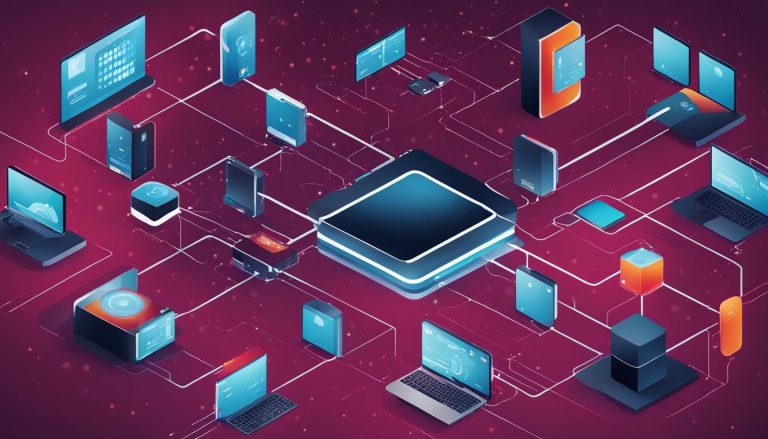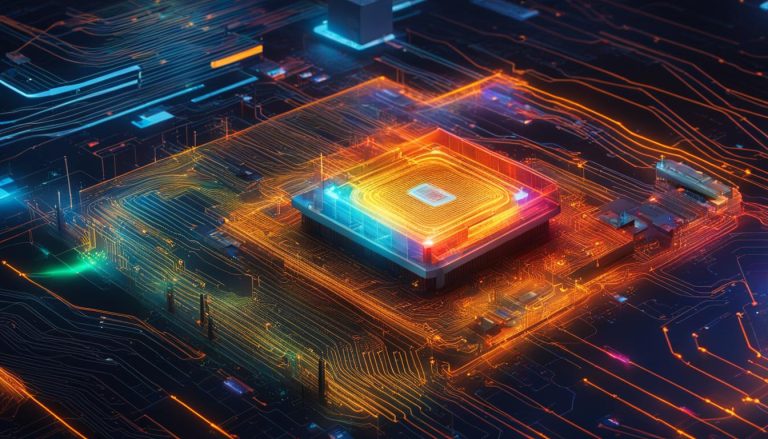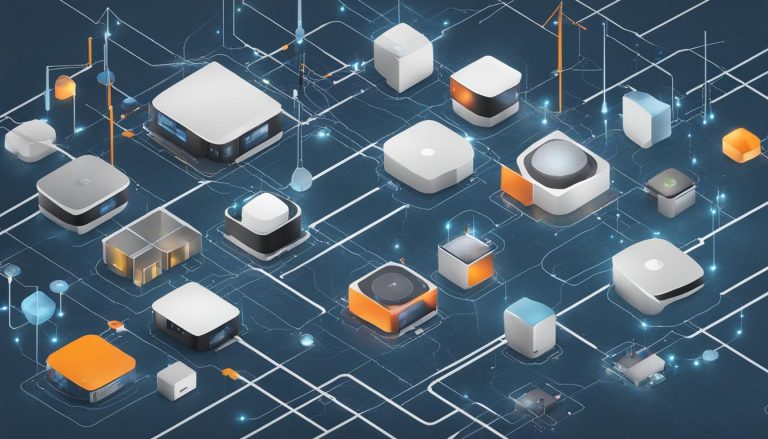Machine-to-machine (M2M) communication is a technology that enables networked devices to exchange information and perform actions without the need for human intervention. It utilizes artificial intelligence (AI) and machine learning (ML) to facilitate seamless communication between systems. Initially adopted in manufacturing and industrial settings, M2M has now found applications in various sectors including healthcare, business, and more. M2M serves as the foundation for the Internet of Things (IoT), connecting devices and enabling a multitude of innovative solutions.
M2M systems utilize sensors to collect data and transmit it to a network, often through public networks such as cellular or Ethernet. The system consists of key components like sensors, RFID, Wi-Fi or cellular communications links, and autonomic computing software. This technology enables remote monitoring, asset tracking, telemedicine, mobile payments, smart home systems, and more across different industries.
Key Takeaways:
- M2M communication allows networked devices to exchange information and perform actions without human intervention.
- M2M technology utilizes AI and ML to facilitate seamless communication between systems.
- M2M has applications in various sectors including manufacturing, healthcare, and business.
- M2M serves as the foundation for the Internet of Things (IoT).
- M2M systems use sensors to collect and transmit data through public networks.
How Does M2M Work?
In machine-to-machine (M2M) communication, devices equipped with sensors collect data and transmit it to a network without human intervention. This data is then interpreted and used to trigger preprogrammed, automated actions. M2M systems often utilize public networks like cellular or Ethernet for communication, distinguishing them from other remote monitoring tools.
The key components of an M2M system include sensors, RFID, a Wi-Fi or cellular communications link, and autonomic computing software. These components work together to collect and transmit data, allowing for seamless communication between devices. The data collected by sensors and devices is translated by M2M applications, which then initiate specific actions based on predefined rules and instructions. This automation enables increased efficiency and scalability in various industries.
“M2M systems often utilize public networks like cellular or Ethernet for communication, distinguishing them from other remote monitoring tools.”
By leveraging M2M technology, organizations can streamline processes, reduce costs, and improve overall operational efficiency. M2M systems find applications in remote monitoring, asset tracking, telemedicine, mobile payments, smart home systems, and more. The ability to collect and transmit data in real-time allows for timely decision-making and enhanced control over interconnected devices.
With its reliance on sensors, wireless communication, and automated actions, M2M technology plays a crucial role in enabling automation, optimizing resource allocation, and driving innovation in various industries.
Applications of M2M Communication
M2M communication has revolutionized remote monitoring and automation across various industries. The technology has found applications in diverse sectors, enabling efficient and real-time data exchange between connected devices. Here are some notable applications of M2M communication:
1. Remote Monitoring and Control
M2M communication plays a crucial role in remote monitoring and control systems. It allows businesses to track and manage assets, equipment, and infrastructure from a centralized location. For instance, in industrial settings, M2M enables real-time monitoring of machinery performance, identifying potential issues before they cause costly downtime. Similarly, in utilities, M2M facilitates remote monitoring of energy consumption, enabling better management of resources and optimizing utility operations.
2. Smart Cities and Infrastructure
M2M communication is a key enabler of smart cities and infrastructure. By connecting various devices and systems, M2M technology enables efficient management of city services, transportation networks, and utilities. For example, traffic control systems can utilize M2M communication to monitor traffic flow, optimize traffic signal timings, and reduce congestion. M2M also plays a crucial role in managing public infrastructure, such as street lighting and waste management, by enabling remote monitoring and control.
3. Healthcare and Telemedicine
In the healthcare industry, M2M communication allows for real-time patient monitoring and remote healthcare services. Medical devices equipped with M2M technology can transmit vital signs and health data to healthcare providers, enabling remote diagnosis and timely intervention. M2M also facilitates asset tracking in healthcare settings, ensuring the availability and proper maintenance of critical equipment and supplies.
These are just a few examples of how M2M communication is transforming industries and enabling new possibilities. With its ability to connect devices, gather data, and facilitate automated actions, M2M technology continues to drive innovation and improve efficiency in various applications.
Key Features of M2M Technology
M2M technology encompasses several key features that make it a powerful tool for communication and automation. These features enable seamless connectivity and efficient data exchange between networked devices. Some of the key features of M2M technology are:
- Low power consumption: M2M devices are designed to operate on low power, ensuring long battery life and energy efficiency.
- Packet-switched service: M2M systems rely on network operators to provide packet-switched service, allowing for efficient data transmission.
- Monitoring abilities: M2M technology enables continuous monitoring of devices, systems, and processes, providing real-time insights and actionable data.
- Time tolerance: M2M systems can accommodate delays in data transmission, ensuring reliable communication even in scenarios with intermittent connectivity.
- Time control: M2M applications can schedule and control the timing of actions and data exchange, optimizing efficiency and resource allocation.
- Location-specific triggers: M2M systems can be configured to trigger actions based on specific location parameters, allowing for targeted automation and response.
- Small data transmission: M2M technology is designed to handle the exchange of small amounts of data efficiently, ensuring minimal bandwidth usage and fast response times.
These key features contribute to the effectiveness and versatility of M2M technology across various industries and applications.
The low power consumption and efficient data transmission capabilities of M2M technology make it an ideal solution for remote monitoring, asset tracking, and real-time data collection. Its ability to handle small data transmissions and location-specific triggers enables targeted automation and enhances operational efficiency.
Example: Key Features of M2M Technology in Action
Let’s consider an example of M2M technology in the context of smart energy management. A smart home equipped with M2M-enabled devices such as smart thermostats, energy meters, and appliances can leverage the key features of M2M technology to optimize energy consumption. The M2M system can monitor energy usage in real-time, adjust thermostat settings based on occupancy and external factors, and communicate with the utility provider to take advantage of off-peak energy pricing.
By utilizing the low power consumption, monitoring abilities, and small data transmission capabilities of M2M technology, the smart home can achieve energy savings, lower costs, and improve overall sustainability. The location-specific triggers of M2M systems can further enhance energy management by automatically adjusting settings based on factors like weather conditions or time of day.
Overall, the key features of M2M technology empower businesses and individuals to leverage the power of connected devices and automation, enabling increased efficiency, cost savings, and improved decision-making.
| Key Features of M2M Technology | Benefits |
|---|---|
| Low power consumption | Extended device battery life, energy efficiency |
| Packet-switched service | Efficient data transmission, reliable connectivity |
| Monitoring abilities | Real-time insights, proactive maintenance |
| Time tolerance | Robust communication in intermittent connectivity scenarios |
| Time control | Optimized scheduling, resource allocation |
| Location-specific triggers | Targeted automation, context-aware actions |
| Small data transmission | Efficient bandwidth usage, fast response times |
M2M vs. IoT: What’s the Difference?
While machine-to-machine (M2M) communication and the internet of things (IoT) are related concepts that involve the communication of connected devices, they have distinct differences. M2M systems are often stand-alone networked equipment that use point-to-point communications. On the other hand, IoT systems bring together disparate systems into one large, connected ecosystem.
M2M systems utilize wired or wireless tools to communicate, whereas IoT systems rely on IP-based networks. M2M technology primarily affects how businesses operate, enabling automation, efficiency, and innovation. In contrast, IoT technology impacts both businesses and end users, providing additional analytics and personalized experiences.
M2M communication focuses on the exchange of data and actions between networked devices, while IoT is concerned with the interconnectivity of systems, devices, and people, creating a broader network of information and functionality.
Although M2M and IoT share similarities in terms of connected devices, they serve different purposes and have varying scopes. M2M systems are typically used in specific applications, such as remote monitoring and asset tracking, while IoT encompasses a wider range of industries and applications, including smart homes, healthcare, transportation, and more.
| M2M | IoT | |
|---|---|---|
| Connectivity | Point-to-point communications | IP-based networks |
| Impact | Primarily on businesses | On businesses and end users |
| Scope | Specific applications | Wide range of industries |
| Functionality | Exchange of data and actions between devices | Interconnectivity of systems, devices, and people |
In conclusion, M2M and IoT differ in terms of connectivity, scope, impact, and functionality. M2M focuses on the exchange of data and actions between networked devices, while IoT is centered around the interconnectivity of systems, devices, and people on a larger scale. Understanding these differences is crucial for organizations and individuals looking to leverage the benefits and capabilities of M2M and IoT technologies.
Security Considerations for M2M Communication
When it comes to machine-to-machine (M2M) communication, security is of utmost importance. M2M systems are vulnerable to unauthorized access, wireless intrusion, device hacking, physical security vulnerabilities, privacy issues, fraud, and the exposure of mission-critical applications. Therefore, implementing robust security measures is essential to protect sensitive data and ensure the integrity of M2M networks.
To enhance M2M security, various measures can be put in place. Tamper-resistant devices are crucial to prevent unauthorized physical access and tampering. Secure back-end servers play a vital role in protecting M2M communication by encrypting data and providing authentication mechanisms. Encryption, whether it’s symmetric or asymmetric, adds an extra layer of protection by encoding data so that it can only be accessed by authorized parties. Device identity management is another essential aspect of M2M security, as it ensures that only trusted devices can establish connections and exchange information within the network. Network segmentation helps isolate critical parts of the M2M system, minimizing the impact of security breaches and limiting unauthorized access.
In summary, securing M2M communication is vital to protect sensitive data, maintain network integrity, and prevent unauthorized access. By implementing measures such as tamper-resistant devices, secure servers, encryption, device identity management, and network segmentation, organizations can mitigate the risks associated with M2M security and ensure the smooth operation of their M2M networks.
| Security Measures | Description |
|---|---|
| Tamper-resistant devices | Devices designed to resist physical tampering and unauthorized access. |
| Secure back-end servers | Servers that provide encryption and authentication mechanisms to protect M2M communication. |
| Encryption | The process of encoding data to prevent unauthorized access. |
| Device identity management | Ensuring that only trusted devices can establish connections and exchange information within the M2M network. |
| Network segmentation | Isolating critical parts of the M2M system to minimize the impact of security breaches and unauthorized access. |
Standards and History of M2M Technology
Machine-to-Machine (M2M) communication has seen the evolution of several key standards over the years. These standards play a crucial role in ensuring interoperability and seamless communication between M2M devices and systems. Let’s explore some of the important M2M standards that have emerged:
OMA DM (Open Mobile Alliance Device Management)
OMA DM is a widely adopted standard that focuses on device management in M2M systems. It provides a framework for managing device configurations, firmware updates, and remote diagnostics. OMA DM enables efficient management of large-scale M2M deployments, ensuring devices are always up-to-date and performing optimally.
OMA LightweightM2M (LwM2M)
OMA LightweightM2M is a lightweight and efficient protocol designed for M2M device management. LwM2M simplifies device provisioning, firmware updates, and sensor data collection in resource-constrained environments. It offers a standardized way to manage a diverse range of M2M devices, from simple sensors to complex industrial equipment.
MQTT (Message Queuing Telemetry Transport)
MQTT is a publish-subscribe messaging protocol widely used in M2M and IoT applications. It provides an efficient and reliable method for devices to exchange data over TCP/IP networks. MQTT’s lightweight design and low resource requirements make it well-suited for M2M communication in resource-constrained environments.
| M2M Standard | Description |
|---|---|
| OMA DM (Open Mobile Alliance Device Management) | A standard for managing device configurations, firmware updates, and remote diagnostics in M2M systems. |
| OMA LightweightM2M (LwM2M) | A lightweight protocol for provisioning, firmware updates, and sensor data collection in resource-constrained M2M devices. |
| MQTT (Message Queuing Telemetry Transport) | A publish-subscribe messaging protocol for efficient data exchange in M2M and IoT applications. |
Standardization in M2M technology has been instrumental in driving its widespread adoption and ensuring interoperability between devices and systems.
Now let’s delve into the rich history of M2M technology. The origins of M2M communication can be traced back to early 20th-century telemetry systems used for transmitting operational data. Over time, advancements in computer networking and the expansion of IP networks paved the way for the development of modern M2M technology.
Today, M2M technology plays a vital role in enabling automation, efficiency, and innovation across various industries. Key players in the M2M hardware components market, such as Quake Global, Digi International, and Wyless Group, continue to drive advancements and shape the future of M2M communication.
As M2M technology continues to evolve, it is crucial for industry stakeholders to stay updated with the latest standards and leverage them to unlock the full potential of M2M communication.
Conclusion
In conclusion, machine-to-machine (M2M) communication is a groundbreaking technology that has revolutionized various industries. By enabling networked devices to exchange information and perform actions without human intervention, M2M has paved the way for automation, efficiency, and innovation.
With the ability to tap into sensor data and transmit it to a network using public networks like cellular or Ethernet, M2M offers numerous benefits. These include reduced costs, increased revenue, and improved customer service. M2M finds applications in remote monitoring, asset tracking, telemedicine, mobile payments, smart home systems, and more.
While security remains a major concern in M2M communication, the development of standards and the implementation of security measures address these issues. M2M technology has a rich history and continues to evolve with advancements in computer networking and the expansion of IP networks.
In summary, M2M communication plays a crucial role in shaping the modern world. As the foundation for the internet of things (IoT), it ensures seamless connectivity and drives the growth of automation and digitization across industries. M2M empowers businesses, improves operational efficiency, and enhances the overall customer experience.
FAQ
What is machine-to-machine (M2M) communication?
Machine-to-machine (M2M) communication is a technology that enables networked devices to exchange information and perform actions without human intervention.
How does M2M work?
M2M systems tap into sensor data and transmit it to a network, often using public networks like cellular or Ethernet. The main components of an M2M system include sensors, RFID, a Wi-Fi or cellular communications link, and autonomic computing software.
What are the applications of M2M communication?
M2M communication finds applications in remote monitoring, asset tracking, telemedicine, mobile payments, smart home systems, and various other industries.
What are the key features of M2M technology?
Key features of M2M technology include low power consumption, network operator providing packet-switched service, monitoring abilities, time tolerance, time control, location-specific triggers, and the ability to send and receive small amounts of data.
How does M2M differ from IoT?
M2M systems are often isolated, stand-alone networked equipment that use point-to-point communications, while IoT systems bring together disparate systems into one large, connected ecosystem. M2M uses wired or wireless tools to communicate, while IoT systems rely on IP-based networks.
What are the security considerations for M2M communication?
Security measures for M2M include tamper-resistant devices, secure back-end servers, encryption, device identity management, and network segmentation.
Are there any standards for M2M technology?
Yes, several key M2M standards have emerged over the years, including OMA DM, OMA LightweightM2M, MQTT, TR-069, HyperCat, OneM2M, Google Thread, and AllJoyn.
What is the history of M2M technology?
M2M communication has a history that dates back to the early 20th century, with the first use of telemetry for transmitting operational data. M2M technology has evolved with the advancement of computer networking and the expansion of IP networks.
Jana is a public relations specialist and writes about all kinds of software products that make our life easier.


